Kristen takes us on a Vorthos journey with a primer on using popular culture to help learn the art of Tarot. In this, the first entry of a series on using MtG art as a lens to look at Tarot, she explores Nahiri as the Five of Swords.
We all are more than what we invest in Magic.
Magic is a big part of our lives, and when that part of our lives becomes tiresome, or toxic, it’s important to remember that our hobbies and interests are as varied and unique to us as our decks. Lockdown has taken away the Gathering, and for me at least, it’s taken with it a big part of what I love about Magic.
Fortunately, there are other parts of Magic that keep me invested, and one of those is the worldbuilding and lore. Despite the . . . let’s say, challenges . . . that come with being a Vorthos these days, I still scan new cards and artwork greedily for the little nuggets of gold that still crop up, like the lineage of the cat on Nine Lives.
This column will aim to explore the Vorthos side of Magic and Meaning similarly to Jacob’s great column. We’ll be looking at how some of the artwork in Magic offers hidden depths of meaning, and how, by applying knowledge of semiotics to popular culture, you can use this as a tool to help memorize and understand the 78 cards of the Tarot.
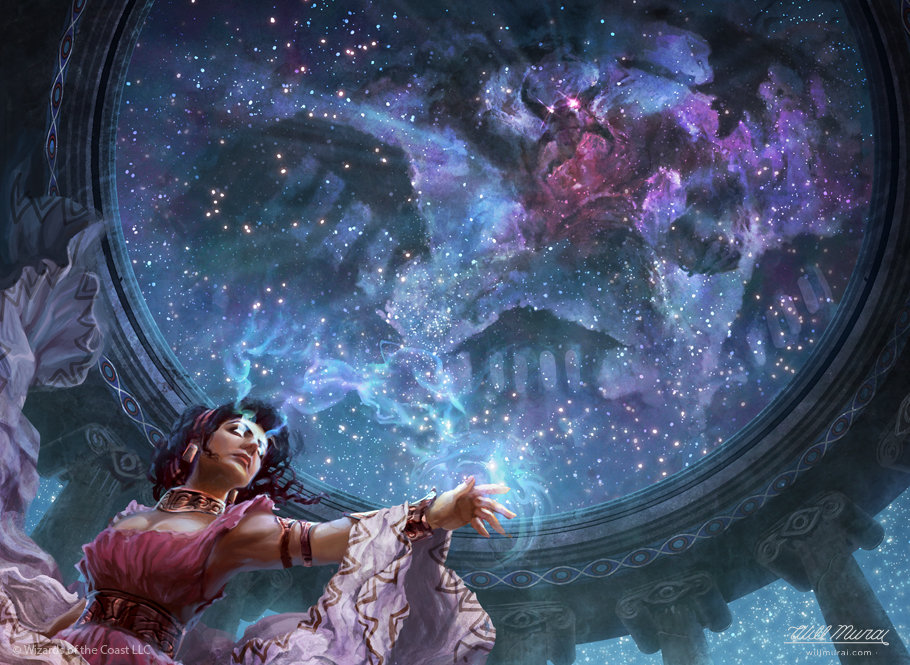
Divination, by Will Murai
The Tarot
Tarot has a long and checkered history. What originally started as a pack of cards for playing games later evolved into decks designed for divination. The earliest Tarot decks were used to play a game similar to what we now know as Bridge, but the use of the cards for other purposes was developing in Europe as early as the 16th century; players would use the cards, dealt at random, to create poetic verses about one another—a kind of Renaissance mad-libs! This retro substitution game went on to become what we now know as the process of a Tarot reading, made famous—or rather, infamous—by Aleister Crowley in the early 20th century.
Tarot today is looked upon either with a healthy skepticism as a harmless pastime, or as a nefarious occult practice shunned by the religious. Whether you believe in the mystical power of the Tarot to predict the future or not, it remains an excellent psychological tool for meditation and therapy. Through a more logical lens, one can make the argument that it’s simply a more complex version of a Rorschach test. The reader will see what they wish to, and utilize the latent ability of the brain to make connections. This is ultimately a way to practice Externalization—abstracting yourself from your thoughts in order to evaluate them objectively. Externalization is a form of meditation, and can be practiced through journaling or even something as simple waiting ten minutes to do your read through of an email before clicking send. Your brain will be in a different place, fostering a more productive evaluation than when it’s wrapped in the emotion in the moment. It’s also the reason leaving the room during an argument often puts things into perspective.
Tarot, then, is a great way to bring subconscious thoughts and desires to the surface and work through them to reach a conclusion. The idea that Tarot is divination comes down to personal belief, but either way, completing the thought exercise of a Tarot reading can lead you to making considered decisions and generally give you more confidence in your analysis of events. I’ll often perform a reading for a friend, or myself, when we’re feeling stressed about a situation with either too many decisions, or decisions that bear weight. By no means do the cards lock in a certain future, or spell doom and destruction (at least, not always); but they do allow for a rational discussion, with pointers for evaluating our personality and our way of handling things.
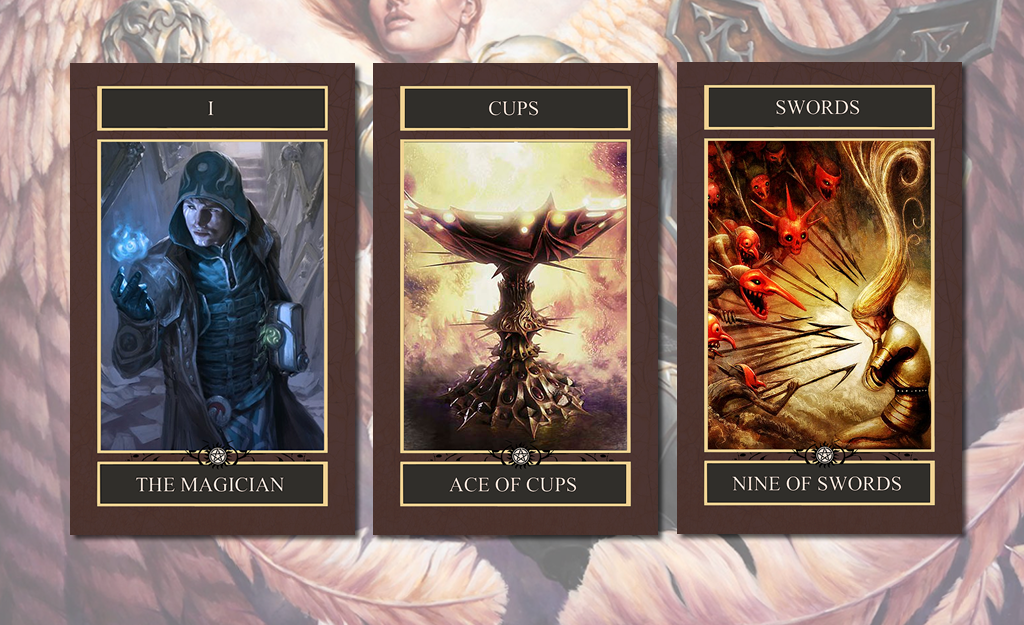
Understanding the Tarot
The idea of ascribing certain characters or personalities to the Tarot is as old as the Tarot itself—indeed, the classical interpretations of the Rider-Waite deck hinge on a grounded knowledge of archetypal figures, mythology, religion, and astrology. Memorizing and understanding the 78 different cards is a tall task; even after a couple of years practice, I still consult my notebook from time to time. One of the things that drew me toward using Magic: the Gathering as a jumping off point for learning the cards of the Tarot was the idea of “Frontloading” information.
Mark Rosewater often mentions Frontloading as a key aspect of game design. In his article on Piggybacking, he outlines the concept with Plants vs. Zombies. Plants are immobile, and Zombies are slow, so it makes sense for a tower defense game to be set up like that. It’s the idea that the audience, or players, come to expect something to work how it does. Whenever an assumption is made that turns out to be true, it’s a victory for the game designer. One of the simplest examples in Magic is the idea that Flying creatures can go over the top of ground creatures. A vast majority of new players can make the connection, because that’s how flying works!
My goal was to use pre-existing connections to learn the Tarot faster and easier. This worked not only because of my knowledge of Magic, but also because the idea of Frontloading as a concept can be traced to the ideas of Structuralism—namely that elements of human culture must be understood by way of their relationship to a broader, overarching system or structure. As far as figures like Claude Levi-Strauss can be criticized for their overly a priori approach, the popularization of the idea of the Mono-myth is in no small part thanks to this school of study; upon delving into and comparing cultures, religions, and myths, it’s apparent that there are many crossovers.
What’s relevant here is what Jungian archetypes draw from that same pool—looking for commonality, patterns, and motifs common across peoples and cultures. These days, we see this commonality in the Myers-Briggs test or the Magic Color Pie. Duncan Sabien wrote a fantastic deep dive on this, which argues that the Color Pie might be a more accurate analysis than the Myers-Briggs test.
I see Tarot as being able to be processed upon a similar axis. The more frontloading of knowledge, the easier the connections. Despite having some good knowledge of religious iconography and archetypes, I would be able to associate more strongly what is signified by the artwork and the associations of a card if it held more inherent meaning to me. I decided to build that association through Magic.
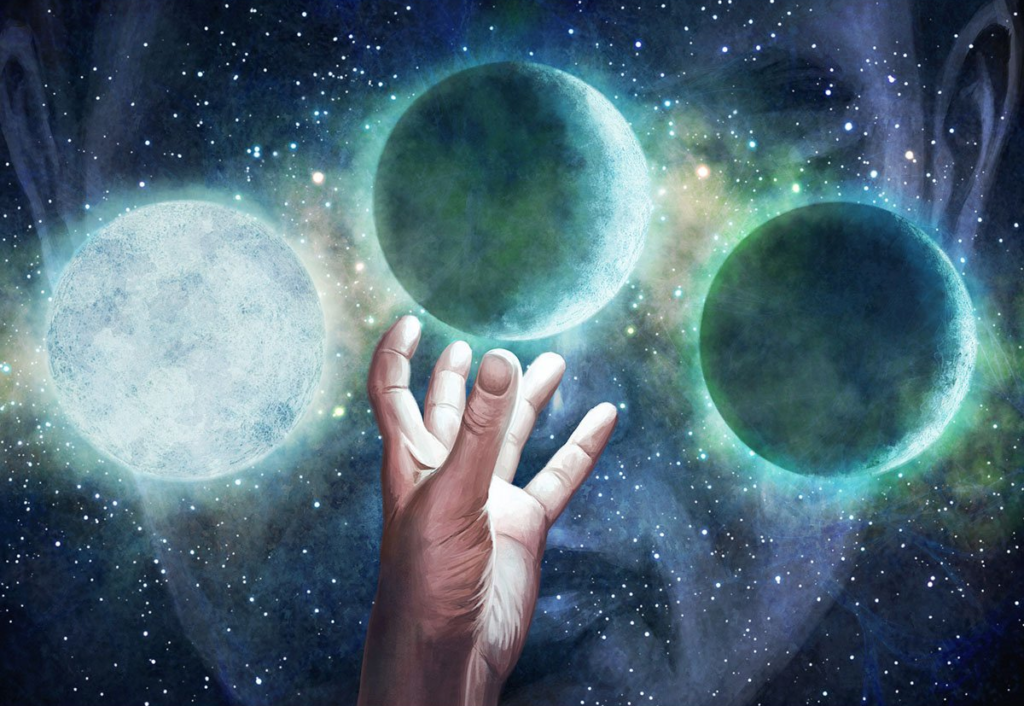
Ponder, by Dan Scott
Magic: the Gathering and Tarot
The use of the Magic: the Gathering framework as a means to interpret the Tarot is not a new idea, from an aesthetic perspective at least. In many ways, seeing projects like @Ishton‘s were what interested me in writing this column, and it inspired thinking about how meaning can differ so much between different people. We live in a post-modern society, and particularly if you’ve studied literature or humanities, you’ll know how much weight is placed on this approach. I’m not about to take that away from you; lived experiences shape our interpretations of art.
I’d like to emphasize, though, that not every character or card fits; and ultimately, in shoe-horning things to fit, you may end up diluting or even changing meaning. Tarot is a little more structured than you’d think, at least from a reading perspective. Without those rules and structures in place, it would not be possible to perform a reading with the cards as they were intended.
In my quest designing a Tarot I can learn from, there sometimes isn’t a relevant character in the Magic mythos that fits a card (enough) to own it completely. In those instances, I’ve followed my own heart, and included non-magic art and characters in my deck too. This series will concentrate primarily on Magic art, but I’ve also used references from The Lord of the Rings and other aesthetically similar universes. On that note, I chose Galadriel for my High Priestess.
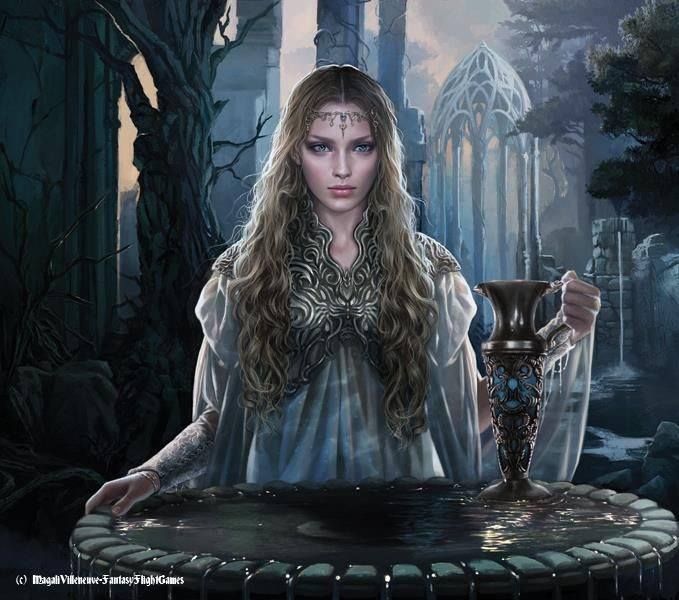
Galadriel, by Magali Villeneuve
The Art of Tarot
In my quest for artwork for my Tarot project, I’ve spent countless hours deliberating on works that fit the cards. Beyond mere physical limitations (the cards being vertical, for instance), the art chosen was very important to me. I can freely admit that I’m not hugely talented in the art department from a production side of things, but when it comes to symbolism, meaning, and aesthetics, I don’t think I did a bad job curating.
One of the eternal questions about analyzing any piece of art is whether symbolism in art is intentional (or whether we should give any credit to the artist’s original intent at all). The artwork for Villeneuve’s Galadriel is draped in mystery. The flowing cloth, hair, and water presents a fluid image, with the reflection of the Moon a literal mirror to our own self-reflection. Galadriel herself is an embodiment of the feminine mystique, and captures the spiritual and supernatural side of the High Priestess well enough on that axis.
More than that, though, the artwork above throws into contrast the dark and light duality present on the Rider-Waite original:
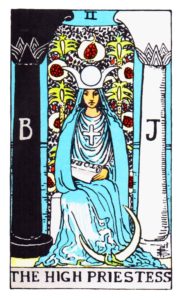
Rider-Waite High Priestess
This is fascinating, because though it was more than likely unintentional on the part of the artist, it does evoke a strong association of an archetypal image. Bingo!
It’s this kind of multi-layered association that I hoped to find by using Magic art and characters, as having a strong foundation is necessary to understanding the multi-faceted nature of the cards. Tarot cards at face value do not always offer a clear image—the most commonly misinterpreted card is Death, which most often means change or rebirth, as opposed to literal physical death. If possible, I wanted the art and characters I picked to have multiple layers of significance to deepen those connections.
Nahiri, the Five of Swords
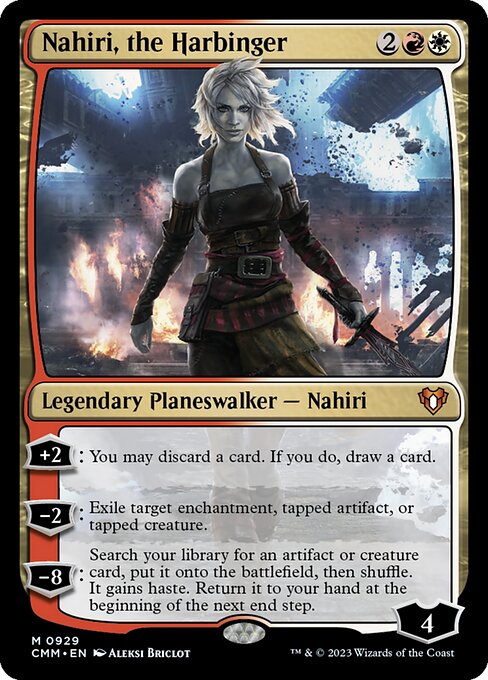
She has a sword, right? Sorted!
All jokes aside (and you can afford me that one after a pretty long preamble), Nahiri having a sword is the first layer of the comparison. Let’s first look at Aleksi Briclot’s artwork, as that discussion is still fresh. There’s a reason I chose this art of Nahiri as opposed to the others. Notice the very obvious imagery around the pentagram shape—there are five distinct angles emanating from the center of the artwork:
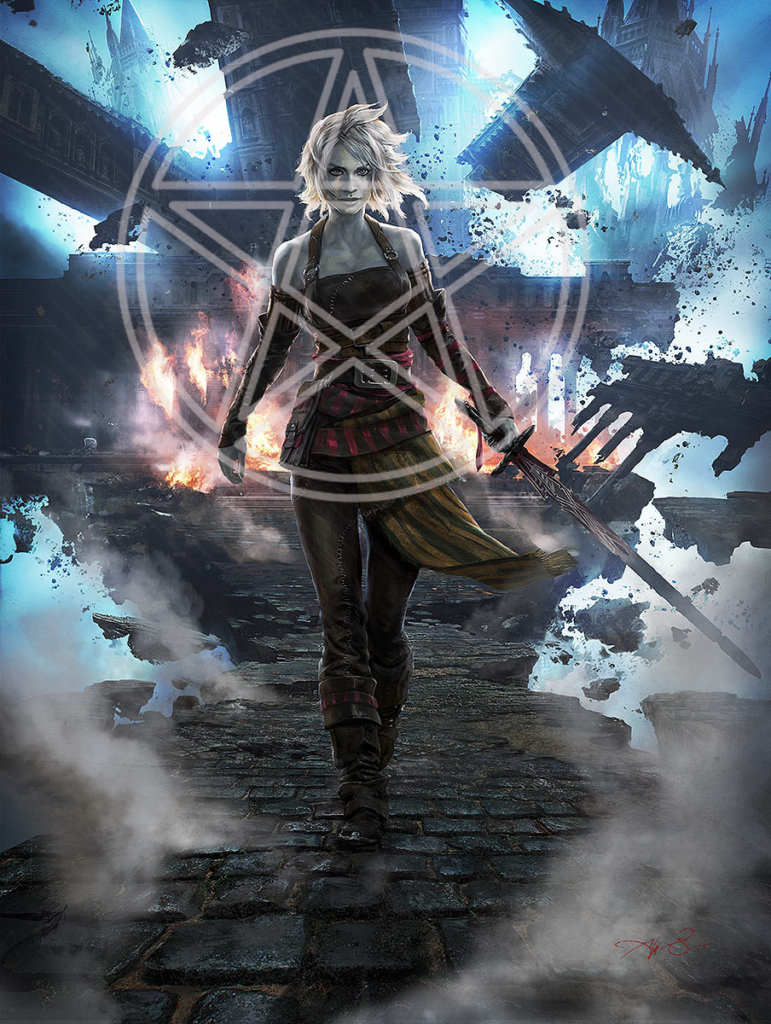
Nahiri the Harbinger, by Aleksi Briclot
The significance of the shape not only lends itself to Nahiri fitting the Five of Swords numerically, but also to expressing two opposing ideals. In the first, we see Nahiri wielding the alchemical elements of Fire and Earth respectively, as is their position in the Pentagram. This is hugely fitting considering her Lithomancy background, and the Structural Distortion she is invoking. She also embodies Spirit (the top of the Pentagram)—in her mind, righteous retribution. It would, admittedly, be pushing it to stretch this comparison further; but if the wings of the Manor fulfill the remaining slots, that would give them the qualities of Air (the sanguine humor of the blood) and of Water (cold, moody and brooding; often associated with diffusion and transformation). Gee, I wonder what race of bloodsuckers that could apply to?
Alternatively, we can draw the Pentagram in reverse if we look at the background, ignoring Nahiri. Turning away from the more literal “Satanistic” interpretation, the reversed Pentagram also symbolises “overturning the proper order of things.” White Mana, with which Nahiri is aligned, is about order. In this plot arc she absolutely overturns that proper order, not only physically on Innistrad, but also spiritually. Nice.
Again, we have no idea if this was intentional. In truth, it could be argued that I’ve made a few leaps myself to make it fit—but fit it does nonetheless, especially if our goal is to achieve meaningful associations. I prefer the former interpretation of an upright Pentagram, as it fits better, but it would be remiss to not examine all possibilities.
The Five of Swords in Tarot
So, what does the Five of Swords mean? Good question. The headlines are self-interest, discord, and open dishonor:
In readings, the Five of Swords can mean that you or someone else is forgetting the larger view of self. You are defining your interests too narrowly. If you try to get ahead in isolation, your actions will come back to haunt you later, one way or the other.
Sometimes this card implies a need to put your own interests first. If you are being abused or taken advantage of, you must get free. If you are worn out by demands, take care of yourself. If it is your turn, step forward and claim your due. Just be aware that if you hurt others in the process, your victory will not feel complete.
The Five of Swords also represents hostility—from an insult to warfare. When the cords that bind us are broken, we experience discord. This card can signify dishonors that are fairly open. Cheats, lies, tricks, deceits, even crimes. You may be on the receiving end, or be the perpetrator. Either way, hold to a larger view of who you are. Find the solution that is best for everyone…including yourself.
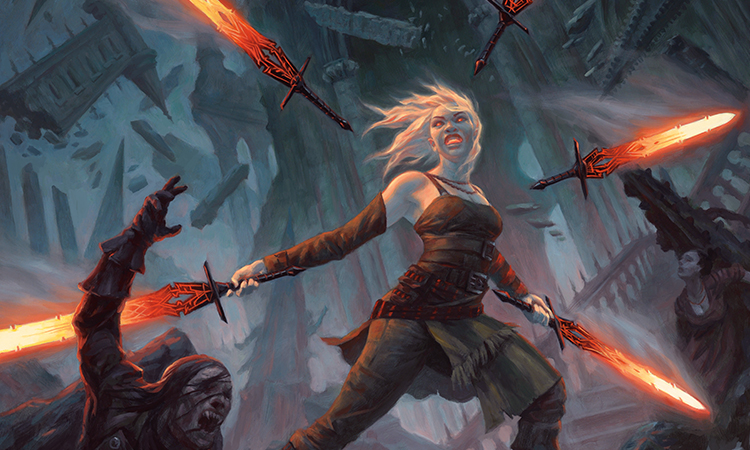
Nahiri’s Wrath, by Chris Rahn
We can see Nahiri here. She has been abused and taken advantage of by Sorin when he locked her in the Helvault. She experienced deceit and discord also, and eventually this ended in warfare. The Five of Swords warns us not to hurt others in the process of retribution, as victory will not feel complete. Though many root for Nahiri over Sorin, none can deny that the way in which she brought vengeance on Sorin was born from isolation and self-interest—I’m almost certain that if she comes “back to the light,” she’ll regret her actions. She is definitely guilty of “losing (her) moral compass,” “letting ends justify means,” “sacrificing integrity,” “losing sight of what is right,” and “achieving a dubious victory.”
Ultimately, the Five of Swords warns us to pick our battles and not become blinded by revenge, hubris, or contempt:
You may be tempted to fight every conflict to ensure you get your way, to prove that you are right, or defend yourself when you are feeling challenged or threatened. However, most experts agree: choosing your battles wisely is a much better way of life than engaging in every disagreement. Not only will it lead to a more peaceful existence, but your interpersonal relationships are likely to come out stronger.
Nahiri is an excellent character to fit the role of the Five of Swords—her passion and relentlessness are intoxicating, enviable, and inspiring. We can all see ourselves in her a little when we’ve been feeling resentful or beaten down. The Five of Swords warns us to move beyond those more base feelings and gives us an invitation to civility and reconciliation. It’s the balancing of Red and White mana.
It’s Nahiri.
In Closing
Tarot is a great psychological tool. I really enjoy using it from time to time to help get perspective on things when I have a mental block. Putting faith blindly in things like this is never advisable. Though I do advocate for Tarot being a fun tool, I would not invest your faith in it predicting anything for you (even if you do have mad skills like me—my friends are terrified).
This has also been a great project for learning the Tarot. If anyone else is looking to learn, I’d suggest starting in a similar vein—pick a card that speaks to you, and ask yourself: who is this? Chances are, there’s a character out there that fits the archetype.
I’ll be taking another piece of art to explore next time. If you enjoyed this piece, let me know on Twitter.
Based in the UK, Kristen is a lover of both Limited and Commander, and can most often be found championing the Boros Legion when called upon to sit down and shuffle up.

